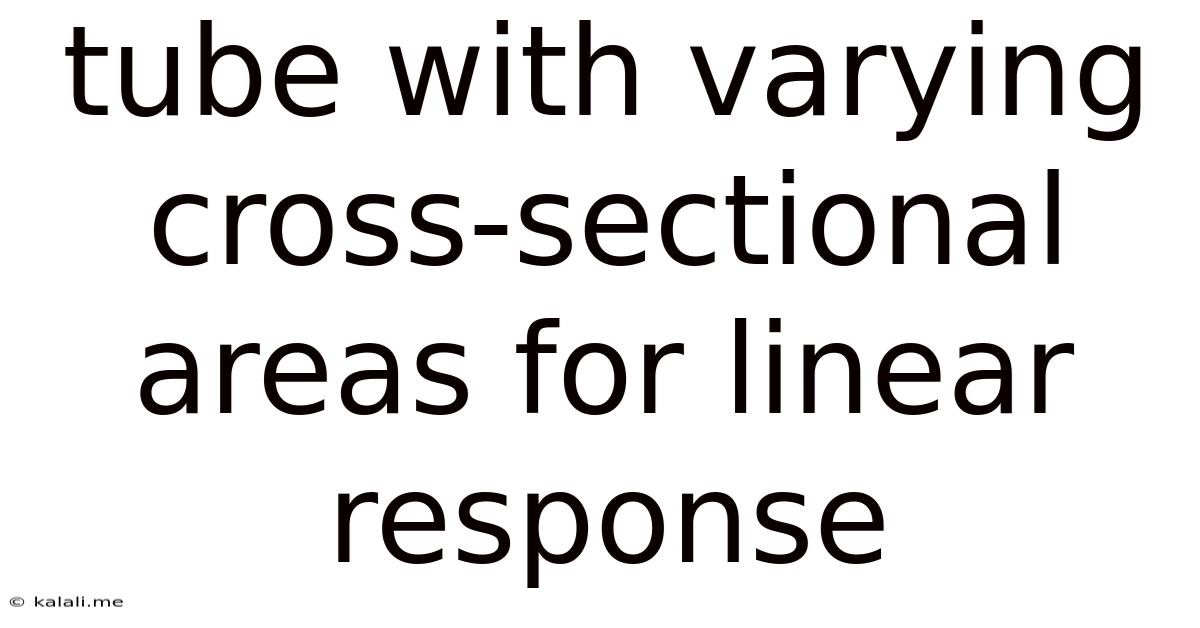Tube With Varying Cross-sectional Areas For Linear Response
Kalali
May 22, 2025 · 3 min read

Table of Contents
Tubes with Varying Cross-sectional Areas: Exploring Linear Response
This article delves into the fascinating physics of fluid flow through tubes with non-uniform cross-sectional areas, specifically focusing on their linear response characteristics. Understanding this behavior is crucial in various applications, from microfluidics and biomedical engineering to designing efficient piping systems. We will explore how changes in cross-sectional area affect fluid velocity, pressure, and ultimately, the overall system response. This analysis is vital for optimizing design and predicting system behavior under various conditions.
Understanding Linear Response
Linear response theory describes the relationship between a system's response and an applied perturbation, assuming the response is directly proportional to the perturbation. In the context of fluid flow through a tube, the perturbation could be a change in pressure or an applied force, and the response is the resulting fluid velocity or flow rate. This linearity simplifies analysis significantly, allowing us to utilize powerful mathematical tools. However, it's crucial to remember that this model holds true only within a certain range of perturbations; exceeding this range leads to non-linear behavior.
Fluid Flow and the Continuity Equation
The foundation of our analysis rests on the principle of mass conservation, encapsulated in the continuity equation. This equation states that the mass flow rate must remain constant throughout the tube, even as the cross-sectional area changes. Mathematically, this can be expressed as:
A₁v₁ = A₂v₂
where:
- A₁ and A₂ are the cross-sectional areas at two different points along the tube.
- v₁ and v₂ are the corresponding fluid velocities.
This equation highlights a crucial relationship: as the cross-sectional area decreases, the fluid velocity must increase to maintain constant mass flow. This principle is directly observable in everyday scenarios, such as the increased water speed in a constricted section of a hose.
Pressure Changes and the Bernoulli Equation
Changes in cross-sectional area also influence the pressure within the tube. The Bernoulli equation, a statement of energy conservation for fluid flow, provides a framework for understanding this relationship. In its simplest form (neglecting viscous effects and changes in height), the Bernoulli equation states:
P₁ + ½ρv₁² = P₂ + ½ρv₂²
where:
- P₁ and P₂ are the pressures at points 1 and 2.
- ρ is the fluid density.
Combining the continuity equation and the Bernoulli equation, we can analyze how pressure and velocity vary along the tube. A decrease in cross-sectional area leads to an increase in velocity, which in turn, leads to a decrease in pressure according to the Bernoulli equation. This pressure drop is an essential consideration in designing systems involving varying cross-sections.
Viscous Effects and Non-Linearity
The analysis presented above assumes ideal, inviscid flow. In reality, viscosity plays a significant role, particularly in narrow tubes or at high flow rates. Viscosity introduces frictional forces that dissipate energy, leading to pressure losses that are not accounted for in the simplified Bernoulli equation. Furthermore, at sufficiently high flow rates, the flow becomes turbulent, and the linear response assumption breaks down completely. More complex models, such as the Navier-Stokes equations, are required to accurately describe these non-linear behaviors.
Applications and Further Considerations
The principles discussed above have broad applications in diverse fields. Microfluidic devices, for example, often utilize channels with varying cross-sections to manipulate fluid flow and perform complex operations. In biomedical engineering, understanding fluid flow in blood vessels with varying diameters is crucial for cardiovascular modeling and disease diagnosis. Similarly, optimizing the design of piping systems requires careful consideration of cross-sectional area variations to minimize pressure losses and enhance efficiency.
Further research can explore the effects of different tube geometries, the influence of fluid properties beyond simple density and viscosity, and the development of more sophisticated computational models to handle non-linear and turbulent flows. The study of tubes with varying cross-sectional areas provides a rich area of exploration in fluid mechanics, offering valuable insights into a wide range of scientific and engineering applications.
Latest Posts
Latest Posts
-
How To Fix Leaking Pvc Joint Without Cutting
May 23, 2025
-
Set Phone To Silent On Schedule
May 23, 2025
-
How To Know If My Macbook Is Charging
May 23, 2025
-
Salesforce Data Raport Output Group By Json
May 23, 2025
-
Blender 4 Liquid Drops Not Falling
May 23, 2025
Related Post
Thank you for visiting our website which covers about Tube With Varying Cross-sectional Areas For Linear Response . We hope the information provided has been useful to you. Feel free to contact us if you have any questions or need further assistance. See you next time and don't miss to bookmark.